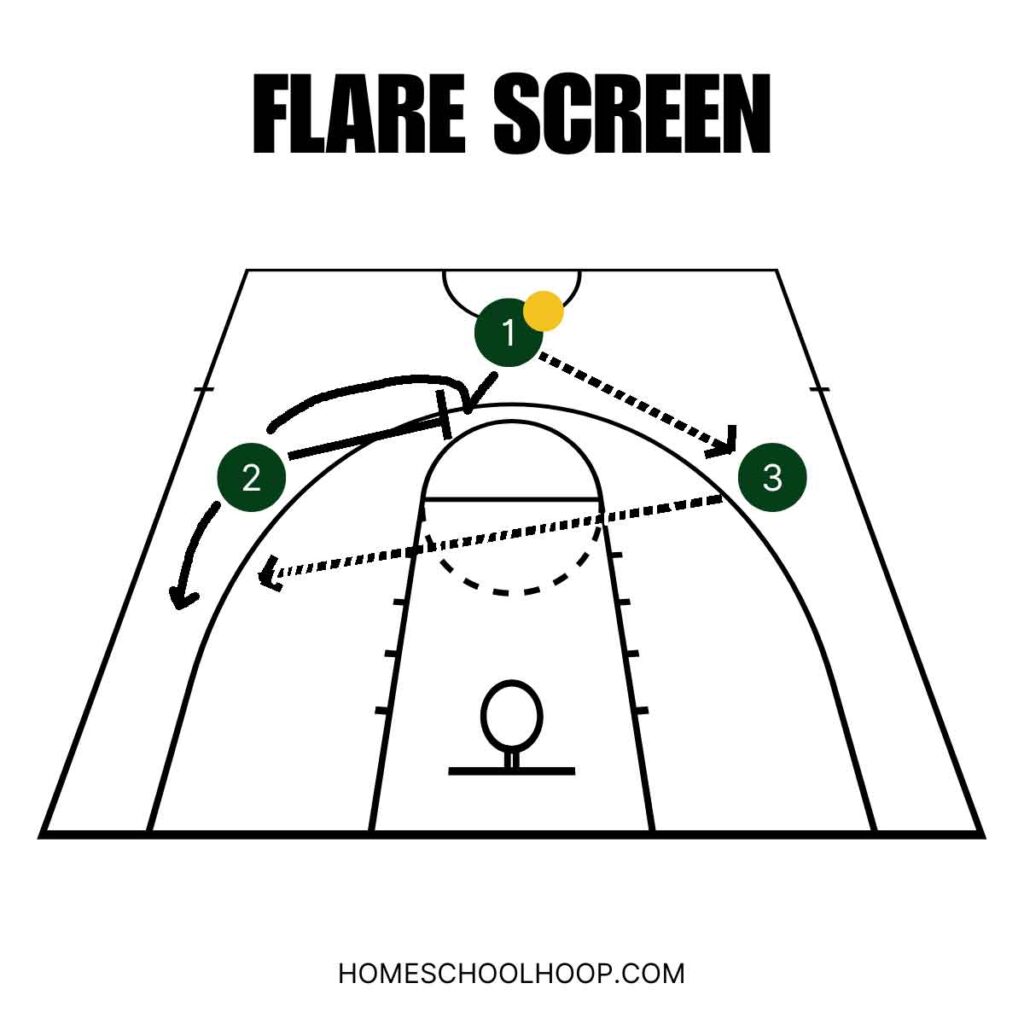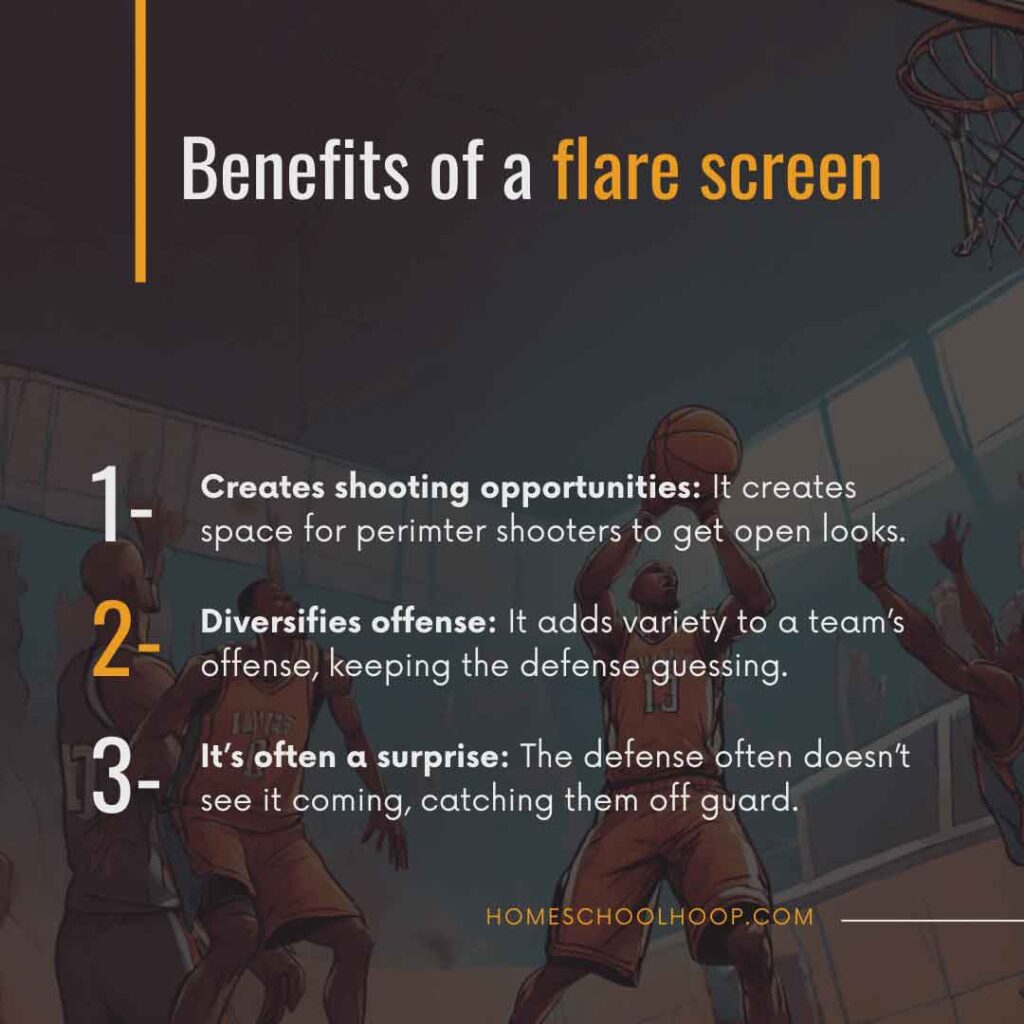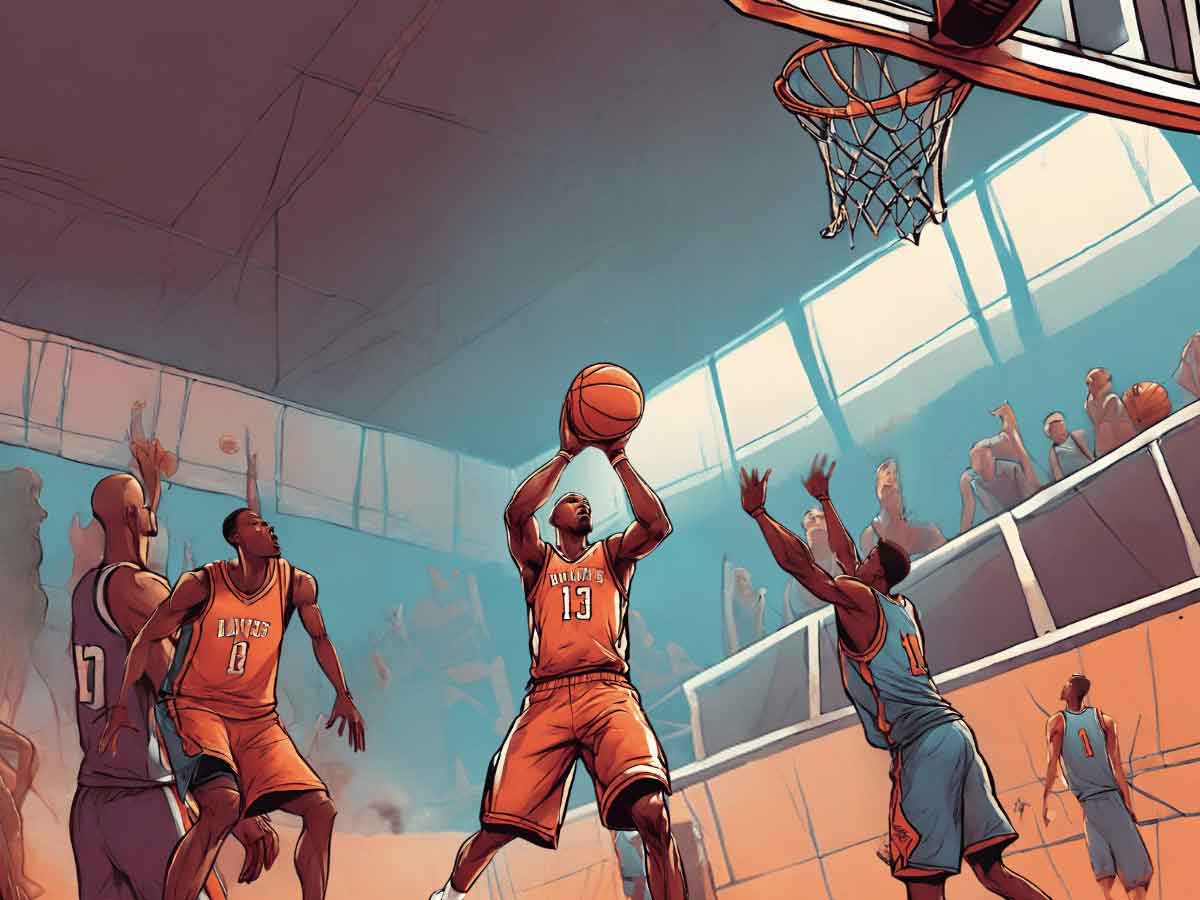A flare screen is a basic but often underused move in basketball. It happens when one player sets a screen away from the ball to help a teammate find open space away from the ball, usually for a shot. A flare screen can be planned as part of a play, or a player might use it suddenly, depending on how they’re being defended.
Key Takeaways:
- Flare screens are used to open up space for perimeter shooters, allowing them to receive the ball in a position to score.
- The player using the screen moves away from where the ball is, rather than cut toward the ball or basket.
- Good timing and coordination between the screener, shooter, and passer are vital for a flare screen to work.
The strength of a flare screen comes from its straightforwardness and the surprise it can create. In this article, we’ll go into detail about how to set up, perform, and use flare screens in different playing situations.
Understanding the Flare Screen
What is a Flare Screen?
A flare screen in basketball is a special type of screen. It’s different from most screens because it doesn’t focus on getting a teammate open near the basket. Instead, it’s used to make space for a teammate further away from the basket, often for long-range shots.

Here’s how it’s different:
- Off-ball action: A flare screen is set away from where the ball is. The players involved, both setting and using the screen, aren’t handling the ball at that time.
- Creates distance: The player using the screen moves toward the outer part of the court, widening the space between them and their teammate with the ball.
- Often a read-and-reaction play: A flare usually happens as a counter. When an offensive player set to come off a pick notices their defender shooting the gap early, they can flare instead.
For defenders, the flare screen is difficult to guard. Similar to the back screen in basketball, it’s hard for the player being screened to see the screen coming, and either fight over or evade it by going under.
4 Steps to Perform the Flare Screen
Executing a basketball flare screen on offense takes a coordinated, four-step process by a screener, cutter, and passer.
1. The screener and cutter set up the screen. The screener gets into position, preparing to block the cutter’s defender. The cutter fakes a move toward the basket to mislead the defender.
2. The screener sets the screen. Having positioned themselves, they hold their stance as a barrier between the shooter and their defender.
3. The cutter uses the screen. After quickly changing directions, the cutter moves away from the ball to the open space on the perimeter.
4. The passer delivers the ball. Watching the cutter make their move, the passer times the pass to reach the shooter as soon as they get open. The cutter catches the pass while already prepared for the shot.
Role in Basketball Offense
The flare screen has a unique role in a team’s offense because it creates room for perimeter shooters. It also often catches defenders off-guard, leading to better scoring opportunities.
- Creating Shooting Opportunities: It opens up space for good shooters. By moving defenders away, it allows sharpshooters to get clear shots, especially from three-point range.
- Diversifying Plays: It adds variety to offensive strategies. Teams can mix flare screens into different plays, keeping the defense guessing.
- Surprise Element: Often used unexpectedly, it can catch defenders off guard, leading to quick scoring chances.

Setting Up the Flare Screen
Successfully pulling off a flare screen takes a similar setup process to any other screen in basketball; a combination of proper positioning, movements, and coordination between the screener, cutter, and passer.
If the timing is off, the screen may not work, leading to a wasted opportunity. But, when done right, it can create valuable scoring opportunities.
The Screener’s Role
- Find the Right Spot: The screener needs to set themselves at an angle to block the defender of the cutter they’re screening for.
- Setting the Screen: Keep a set position, without leaning or extending the arms and legs, to avoid an illegal screen foul.
- Awareness: Be ready to respond to the cutter’s actions. If they flare as expected, roll to the basket. If they instead curl or in some other way cut to the basket, replace the open space they left and be ready to catch a pass.
The Cutter’s Role
- Initial Movement: Start by misleading the defender by moving in the opposite direction of the screen.
- Use the Screen: As the defender comes with you, quickly change direction, setting them up to run into the screener as you move away from the ball and toward the open space created by the screen.
- Prepare for the Shot: Have your feet ready and your body positioned to quickly take a shot as soon as the pass arrives.
The Passer’s Role
- Full Vision of the Court: Keep your head up so you’re able to watch your teammates as they execute the flare screen.
- Ball Fake: Avoid telegraphing where you play to pass by faking a pass in another direction to get your defender off-balance.
- Deliver the Pass on Time: Time the pass precisely, so that it arrives just as the cutter arrives into the open space created by the screener.
Flare Screens in Action: Real-Game Scenarios
Witnessing flare screens in action is the best way to learn about their effectiveness. Below are three video examples showcasing flare screens used by the pros.
Golden State Warriors with Stephen Curry
With sharp-shooting Stephen Curry on their roster, the Golden State Warriors incorporate flare screens to get him open looks. In the play shown in the video below, Curry first sets a ball screen for his teammate at the top of the court. Simultaneously, one of their forwards positions himself to screen Curry’s defender. Curry uses the flare screen to move to an open space in the corner, ready for a shot.
Chicago Sky with Allie Quigley
When the Chicago Sky had great shooter Allie Quigley on their team, they would run a simple flare screen with their largest player to create open space for her. The screen opens space for her to shoot a three, create off the dribble with the help of a pick and roll, or curl to the basket.
Las Vegas Aces with A’ja Wilson and Kayla McBride
Here’s another example from a few years ago with the Las Vegas Aces. A’ja Wilson sets a flare screen to open up an overhead pass to Kayla McBride in the low-wing area. With her defender still recovering high, McBride decides to drive baseline.
Training and Drills for Perfecting the Flare Screen
Pulling off an effective flare screen takes practice. Repetition helps develop muscle memory and a better understanding of timing and spacing.
The following are basketball drills and tips for coaches and players to help integrate flare screens into their training sessions. They mimic actual game situations and are best done at game speed. Allow players to step into every role so they better understand the dynamics of the play.
Drills for Flare Screens
1. Flare Screen Drill
- Setup: Pair up players, one as a cutter and the other as the screener.
- Action: Practice setting and using flare screens with and without a defender.
- Focus: Emphasize timing, quick change of direction,and footwork for a quick shot.
2. Shooting Off the Flare Screen
- Setup: Same as above.
- Action: After executing a flare screen, the shooter receives a pass and takes a shot or drive to the basket.
- Variation: Incorporate different shooting spots to simulate game scenarios.
- Focus: Develop shooting rhythm and skills off a flare screen.
Common Mistakes to Avoid
- Moving screens: The screener has to stay still while setting the screen to avoid a moving screen call.
- Poor timing: The shooter and screener have to move in sync. Mistimed movements can result in a failed screen and potentially an offensive foul.
- Predictability: Repeatedly using the flare screen in the same way over and over can make it predictable.
- Ignoring the defender’s actions: Both the screener and shooter need to be aware of the defender’s position and movements so they can react and adjust accordingly.
FAQs
What is a flare screen in basketball?
A flare screen in basketball is a play where one player sets an off-ball screen to help a teammate find open space away from the ball and on the perimeter, usually to get open for a shot.
How do you set a flare screen?
To set a flare screen, a player positions themselves between their teammate and the teammate’s defender. The key is to do this away from the ball and at an angle that allows their teammate to move to an open space that is further away from their teammate with the ball.
What is a flare cut?
A flare cut is the action taken by the cutter coming off a screen. After the screen is set, the shooter reads that their defender has shot the gap early, so decides to cut ‘flare’ away from the ball handler and toward the perimeter, finding open space to receive a pass.
HAVE ANY MORE TIPS?
Today, we covered the flare screen in basketball.
So we want to know: If you’re a coach or a player, what other tips would you offer for mastering the flare screen?
Share your insights in the comments.

